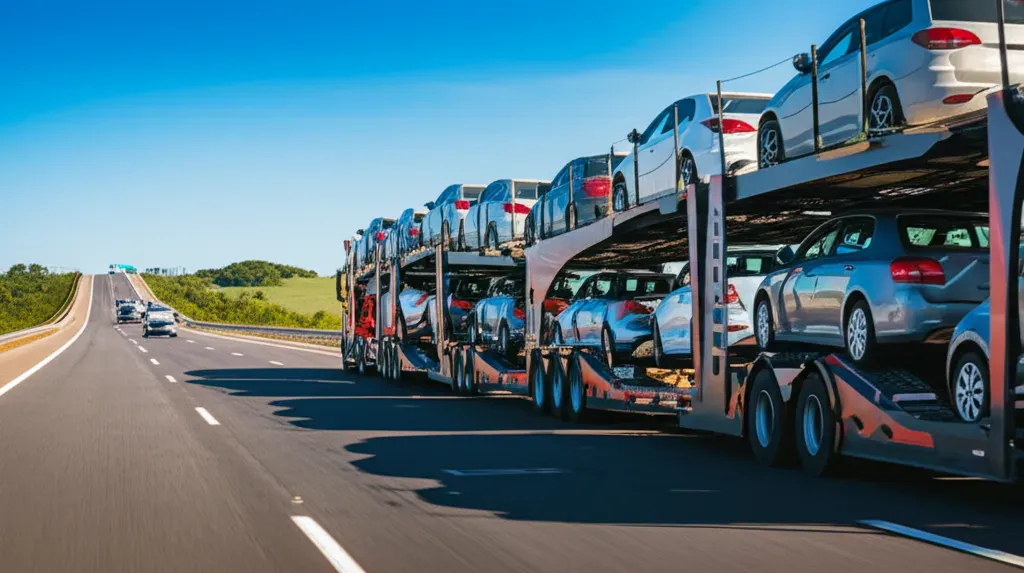Planning an Electric Vehicle Transport in 2025
Everything EV owners should consider in 2025, from pre-transport battery prep and software settings to carrier selection and delivery check-ins.

How do you prepare an electric vehicle for transport in 2025?
Start by giving the vehicle a fresh software and firmware check. Most 2025 models push over-the-air updates that can alter thermal management and battery conditioning. Install pending updates several days before pickup so you can confirm charging profiles and any new transport guidance in the owner app. Then wash the exterior and interior so the carrier can document every panel during inspection; clean surfaces make it easier to spot damage should a claim ever be necessary.
Document the vehicle’s current range, mileage, and software versions in the app or in a shared folder with our operations team. These records help align expectations with your carrier and create a baseline for delivery day. Keep a copy of your registration, proof of insurance, and any manufacturer transport advisories within easy reach for the driver.
What battery state of charge is safest before handing the EV to a carrier?
Aim for a 40–60% state of charge. This range protects battery health, preserves regenerative braking functions, and leaves headroom for the carrier to shuffle vehicles during loading. In 2025, many manufacturers warn that handing over a battery at 100% can stress cells if the vehicle remains idle on a warm lot. On the other hand, letting the charge dip below 20% limits the driver’s ability to reposition the vehicle and can delay delivery because it may need an emergency top-off.
If your route runs through extreme climates, talk with our dispatch coordinator about preconditioning. Some EVs now feature transport or service modes that disable scheduled charging and reduce phantom drain. Activating that mode right before pickup keeps the battery stable during transit.
Which carrier equipment should you request for an electric vehicle?
For most EVs, a well-reviewed open carrier with low-gradient ramps is sufficient. Request a driver who has handled vehicles with longer wheelbases, since many EVs have battery packs that demand careful breakover angles. If you own a luxury or performance model, consider enclosed transport with E-track tie-downs that secure at the wheels rather than the suspension. This setup keeps battery packs from absorbing additional stress during cross-country hauls.
When you book, confirm the carrier brings insulated gloves and wheel chocks. They reduce the risk of static discharge and keep regenerative braking systems stable while loading. Share any custom lowering kits or aftermarket accessories in advance so we can ensure the trailer’s clearances work with your vehicle.
How should you protect charging gear and loose technology?
Remove portable charging cords, adapters, and home wall-box cables from the vehicle. Label and store them in a weatherproof tote that you either ship separately or hand directly to the driver for inventory. Modern EVs also include removable infotainment controls, dashcams, and subscription dongles that you don’t want rattling around the cabin. Secure them at home or note them on the condition report before loading.
If your vehicle uses a mobile access card or phone key, create a temporary driver profile with limited permissions. That profile can unlock the car, shift into drive, and adjust mirrors, but it should restrict access to payment methods or stored locations. Once the vehicle arrives, delete the profile and confirm that primary keys still work correctly.
How do inspections and documentation change for EV transport in 2025?
Expect a longer inspection on pickup day. Our carriers log exterior photos, note tire tread depth, and document the battery state of charge in the bill of lading. We also photograph the infotainment screen showing your mileage and software version. These records protect you if a warranty or insurance claim ever requires proof of condition.
At delivery, run through the same checklist with the driver before signing off. Verify that the state of charge matches expectations, look for error messages about battery temperature, and test advanced driver-assistance systems on a short drive. If anything feels different, contact our post-delivery support line within 24 hours so we can investigate with the carrier.
Where can you find support while your EV is in transit?
Use our tracking portal to monitor the truck’s progress and communicate with dispatch. We keep status updates current with GPS pings and driver check-ins, especially when weather or charging detours shift the timeline. If you need to share updates with a dealership or fleet manager, export the milestone report and forward it directly.
While we manage the logistics, your manufacturer resources remain valuable. Bookmark your automaker’s roadside assistance line and consult their transport FAQ for model-specific advice. Combine that guidance with our route planning, and you’ll have a smooth handoff when the vehicle reaches its destination.
Need next steps?
If you’re ready to secure transport, connect with your coordinator through the client dashboard or schedule a call. We can finalize pickup windows, confirm carrier equipment, and share the inspection checklist you’ll use on delivery day.
Prefer to do more research first? Explore our other guides on seasonal planning, enclosed transport, and fleet moves for deeper context before you lock in a route.
Our support team is available by phone or chat, and you can always review transport milestones inside the dashboard.
Looking for additional shipping insights? Browse more topics on the Autoblog to round out your transport plan.
